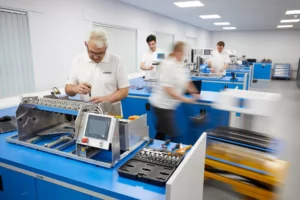29th June 2018; Nottingham, UK: New products from Copley Scientific enhance its offering for improving IVIVCs for orally inhaled and nasal drug products (OINDPs). Improved IVIVCs support more efficient product development through the use of patient-representative breathing profiles during aerodynamic particle size distribution (APSD) measurements. Copley now offers a new air compressor, compressed air manifold and an automated compressed air flow controller for automated air flow control in enhanced IVIVC test set-ups, providing users with a fully integrated solution that simplifies measurement and improves data integrity.
‘Using a breathing simulator to investigate the impact of breathing profile on product performance enhances the value of cascade impaction in product development, bringing it closer to the clinical environment, but calls for precise air flow balancing through the test system,’ said Anna Sipitanou, Business Development Manager, Copley Scientific. ‘With manual control, fluctuations in the compressed air supply directly impact APSD data quality. These new products, when used with the TPK™ 2100 Critical Flow Controller, dramatically accelerate test set-up, at the same time ensuring that test conditions are both accurate and stable. The result is better quality data, with substantially less effort.’
Measuring more clinically realistic APSD data requires the use of a breath simulator, coupled to a cascade impactor using a mixing inlet. This set-up allows a constant flow rate to enter the cascade impactor, while the variable flow rate associated with a patient-representative breathing profile passes through the inhaler under test. Flow balancing in the system is achieved using a compressed air supply, which is now automatically controlled, significantly improving robustness, reproducibility and the speed of testing.
The new air control products significantly enhance Copley’s solutions for measuring more clinically representative APSD data and are a direct response to customer feedback. Other notable, recent additions in this area include a re-designed Next Generation Impactor (NGI) Cooler, used to reduce droplet evaporation, and NGI Cooler Stand, both of which form part of an optimised solution for nebulisers. The modified twin-port NGI Cooler now accepts a mixing inlet, while the NGI Cooler Stand efficiently accommodates a breath simulator. Researchers looking to achieve better IVIVCs now have a comprehensive range of products that work seamlessly and efficiently together to deliver high quality test data, for all OINDPs. To find out more contact: sales@copleyscientific.co.uk
CAPTION: Copley Scientific’s efficient, integrated solution for measuring clinically representative APSD data for nebulisers, complete with twin-port NGI Cooler, NGI Cooler Stand and automated compressed air flow control.
About Copley Scientific
Copley Scientific is widely recognised as the world’s leading manufacturer and supplier of inhaler test equipment and is a major provider of testing systems for other pharmaceutical dosage forms. The company also supplies equipment for detergent testing.
Copley Scientific’s pharmaceutical product range includes test equipment for all types of orally inhaled and nasal drug products – metered-dose inhalers, dry powder inhalers, nebulizers and nasal sprays – with a particular focus on solutions for delivered dose uniformity and aerodynamic particle size distribution measurement. It also includes testers for tablets (dissolution, disintegration, friability and hardness) capsules, powders, suppositories, semisolids and transdermals.
Used from R&D through to QC, this extensive range of equipment is supported by a full validation and aftersales service. Copley Scientific has offices in the UK and Switzerland and works in partnership with aerosol particle science experts MSP Corporation in North America; specialist distributors extend localised support across the world. This network provides expert help and training to every customer, directly enhancing the application of all Copley Scientific products. www.copleyscientific.com








